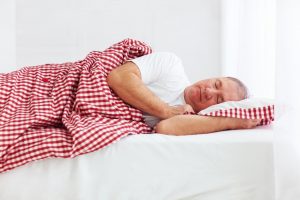When you’re a caregiver for a senior citizen, you know how critical it is to find chairs, beds, and couches that are comfortable for your patients. Choosing the right mattress is especially crucial for the elderly. People in the 65+ age range often suffer from chronic pain related to sore, tender muscles, arthritis, and old injuries that have worsened as the years have passed.
A poor mattress can make even a teenager wake up feeling sore and tired, but for seniors, the effects of a poor mattress can cause debilitating pain and worsen inflammation. Senior citizens need a supportive mattress that cradles sensitive areas that are prone to soreness and stiffness, such as the hips, neck, shoulders, and the lower back. It’s also a good idea to choose a mattress with a comfortable top that cushions the heels and elbows, which will lessen inflammation and irritation.
There are tons of different mattress materials, thicknesses, and designs to choose from, but how do you know which one is going to give your senior patients a comfortable night’s rest? Below, we’ve broken down the different types of mattresses and how they can help seniors sleep well and wake up free from discomfort and pain.
What types of mattresses are the most comfortable for seniors?
When searching for a good mattress for an older individual, manufacturers won’t advertise that it’s the best for senior citizens. What you’ll need to do is look for certain traits and design features that will most likely work for an elderly sleeper.
Typically, seniors need a bed that will retain minimal body heat and will sleep cool. Beds that minimize and isolate movement or motion transfer, and are quiet are usually the best choices for seniors, too. You’ll also want to purchase a bed that is supportive and won’t sag or compress too much. Mattresses that are too soft don’t support spinal alignment and can cause someone to wake up in the morning with a sore back and hips.
Most importantly, a mattress for senior citizens needs to support arthritic joints. As people age, the cartilage that naturally cushions and supports the joints wears away, so seniors need a little more support from their beds than a younger individual.
Gel Memory Foam Mattress
Gel memory foam mattresses are some of the most popular choices for seniors. Gel memory foam is denser and more supportive than traditional memory foam, offering a slightly firmer bed that does an excellent job of supporting the joints and the spine. In mattress lingo, gel memory foam is also referred to as Tempur foam. Gel memory foam mattresses are also cooler than a regular memory foam mattress. Loom and Leaf is one of the more popular gel memory foam mattresses this year.
Memory Foam Mattresses
Memory foam is a mattress favorite, and it’s been around for decades. First used by NASA, memory foam is a high-quality material that offers superior comfort and cushioning. While memory foams aren’t typically as supportive as a gel memory foam mattress, some models are firmer than others.
Memory foam mattresses cradle and cushion the body, so elbows and heels aren’t resting on a surface that can cause skin irritation. Seniors who are side sleepers can most benefit from a traditional memory foam mattress. Memory foam cradles the shoulder joint and allows it to rest comfortably while keeping the shoulder disk in proper alignment.
However, if a person has never slept on a memory foam mattress, the new bed may take some getting used to. Memory foam beds have a particular and distinct feel to them. Also, be sure to check the bed’s cool rating. Memory foam beds tend to run hot. Nectar memory foam beds are some of the highest rated bed-in-a-box mattresses.
All-natural Latex Foam
A natural, latex foam mattress is an excellent alternative to memory foam mattresses for older sleepers. Latex is a springier material than either gel or memory foam. Latex doesn’t cradle the body, so for sleepers who switch positions a lot, a latex mattress can be ideal. However, all natural latex mattresses are sometimes too soft for people with severe arthritis. A high-quality all natural latex foam mattress for seniors is the Santa Cruz Natural Mattress.
What about innerspring mattresses?
Innerspring mattresses don’t always offer enough consistent support for seniors who need cushioning for aching joints. But adding a pillowtop to an otherwise decent innerspring mattress can offer enough softness and support for senior citizens. Boxtop and pillowtop mattresses are suitable for sleepers who are light or medium weight. But these mattresses won’t provide enough support or last very long for heavier sleepers.
Can you choose a mattress that uses different types of materials?
It’s possible to find a mattress that uses different technologies. For example, manufacturers who specialize in innerspring mattresses often have products that use a top layer of natural latex foam, or memory foam for added support and comfort. If you’re worried that your senior patients won’t be able to get used to a full memory foam mattress, an innerspring memory-foam hybrid can be a good compromise.
As always, it’s essential to thoroughly research different mattress types, product ratings, and what’s going to work best for an individual patient.

